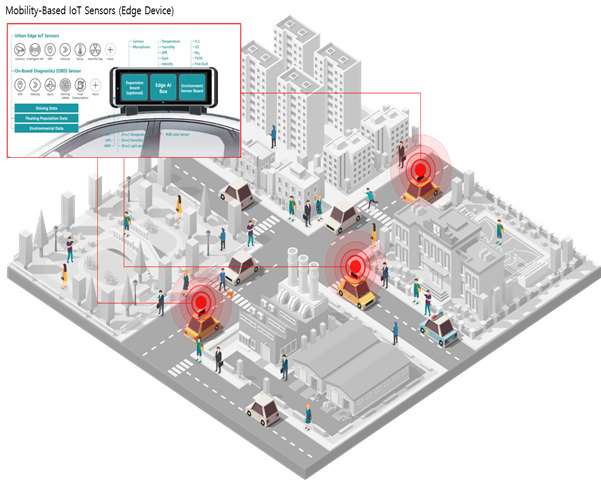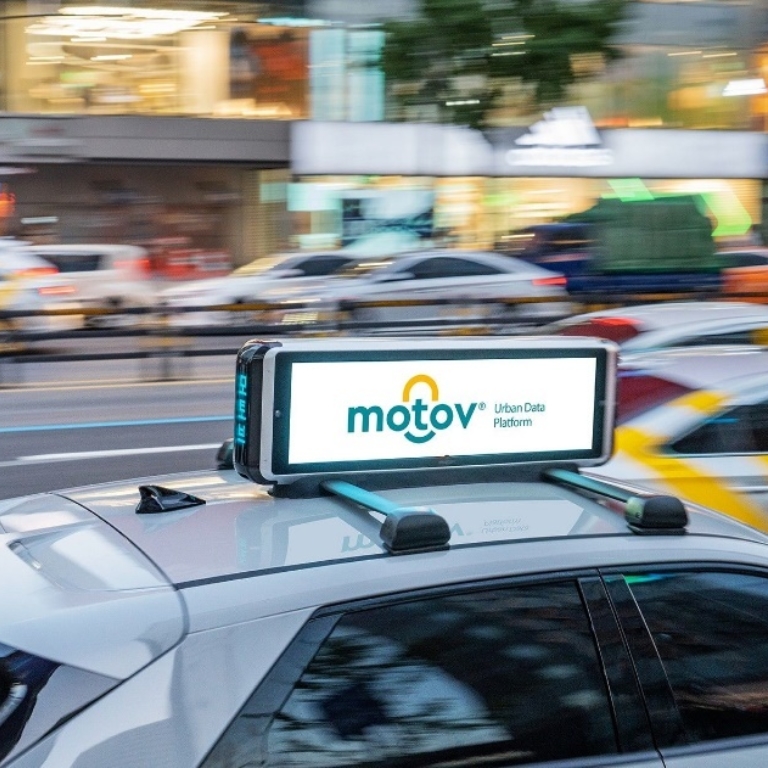5G Transformation Hub
How 5G can make cities safer and healthier
5G-based monitoring could help reduce social costs of air pollution by US$ 50 per person per year
Motov is preparing to test how 5G connectivity, supplemented by mobile edge computing, can help identify and predict traffic hazards and air pollution in the city of Incheon in South Korea. More than 50 types of data will be collected by cameras, microphones and other sensors in a 5G connected unit mounted on the rooftop of taxis. If the trial is successful, Motov plans to use 5G to underpin its “urban road safety management system” in other cities from 2023.
Select a project
Contents
Challenge
Some of the proposed use cases need real-time data, such as the number of people in a specific location, together with gender and age data about individuals. To protect privacy and improve efficiency, some of the collected data needs to be anonymised and filtered by the units mounted on the vehicles. A lTe network doesn’t provide sufficient capacity, in terms of speed, latency and reliability, to meet all the demands of this use case.
SOLUTION
Motov will deploy artificial intelligence on the taxi rooftops units to anonymise and filter the data they collect. The units will then use 5G connectivity to transmit the resulting data to edge compute infrastructure, where it can be analysed to provide individuals with tailored information about road safety and health risks. The 5G connectivity will also enable Motov to determine the precise location of the vehicles without needing to use GPS.
Impact & Statistics
Motov believes its 5G-based road safety solution will help to reduce the number of accidents by 10% to 40% in a specific locality, depending on accuracy of existing measurement systems. by capturing very precise air quality data, the solution could also reduce the social cost of pollution by about US$50 per person per year, according to Motov’s estimates.
Wider Implications
With access to precise real-time data about events in their cities, policymakers and citizens can make better- informed decisions that will improve the quality of urban life. by making the roads safer, Motov’s solution could also encourage more people to walk or cycle in Asia’s congested cities, potentially further reducing air pollution and greenhouse gas emissions.
Stakeholders
Motov, mobile operators.
02
How 5G can make cities safer and healthier
5G-based monitoring could help reduce social costs of air pollution by US$ 50 per person per year
Taxis can do much more than simply move people from place to place. They can also act as the eyes and ears of the city administration and citizens. equipped with mobile sensors, they can detect potential road hazards and monitor air quality. Via 5G, this data can be shared with mobile users, drivers and pedestrians in real-time.
Based in Incheon in South Korea, Motov is developing an “urban road safety management system” by capturing data from sensors integrated into digital advertising units mounted on the roofs of taxis and government-owned vehicles. Motov is now using 5G and edge computing to enhance this system, which is designed to identify and predict traffic hazards and inform drivers and pedestrians.
Motov says its IoT sensors, such as cameras, microphones and air quality monitors, will collect more than 50 types of data as they drive through Incheon Metro city. The units will collect data on weather, temperature, illumination, foot traffic, the vehicle’s driving performance, road condition, and other variables. On-board the units, artificial intelligence (AI) will filter the data before it is transferred via 5G to an edge compute facility.
Motov plans to use the solution to evaluate individuals’ road safety, the stability of the urban environment, and health risks in real-time and then notify them via a mobile app. Motov also intends to notify nearby vehicles about an emergency situation when a traffic accident or hazard has been identified in the region. local government officials and the transport authorities will be able to access real-time maps that indicate the level of risk in each part of the city (see graphics).
For the proof of concept, scheduled for the first half of 2022, Motov is working with the city of incheon and one of the largest mobile operators in korea. it intends to finalise the 5G rooftop unit by the end of the second quarter for deployment on taxis during the third quarter. It plans to test the system in the field in the second half of 2022, installing the AI system during the fourth quarter. If all goes well, Motov intends to roll out a commercial product in 2023. “We’ll be able to expand the scope of the project and apply the system to other regions if this project is successfully carried out in Incheon City,” notes Lim Woo-hyeok, CEO of Motov.


03
Protecting privacy and balancing computing resources
Motov is planning to employ several AI models to support road hazard detection, people counting, age and gender classification and urban sound detection. To protect the privacy of individual citizens, the collected data will be anonymised and filtered in real-time by AI deployed on the units on the roofs of the taxis.
However, as the rooftop unit will have limited computing resources, it may be unable to run all the necessary AI models to support a specific application. In such cases, Motov plans to employ computational offloading – transferring the more complex computational tasks to edge computing capacity elsewhere in the city. This computational offloading will be managed by an AI model that redacts/manages private information and applies other filters to reduce the amount of data that needs to be transmitted.
“Only the AI inferences for de-identification of private information, such as human faces, car plates, other personal possessions, and estimation of real-time floating population demography will be performed” within Motov’s rooftop device, explains Lim Woo-hyeok. “Whereas, relatively heavy AI models, such as traffic hazards and on-road object detection, will be operated by edge infrastructure.”
Motov also plans to use AI in the edge infrastructure to prevent individuals receiving the same notifications from multiple rooftop units, thereby reducing unnecessary data transmission and energy consumption. Moreover, Motov will also use AI to cross-check data from multiple taxis to ensure the information it is collecting from the sensors is accurate: Frequent changes in the temperature and humidity can require individual sensors to be recalibrated.

04
Building on 4G foundations
Founded in 2016, by Lim Woo-hyeok, Motov has spent the past five years developing and deploying connected advertising units that can be mounted on the top of taxis. It adds various sensors to these units depending on the raw data needs of the specific project. Currently working in Seoul, Incheon, and Daejeon, Motov has more than 1,000 connected units deployed on taxis in Seoul.
To make money, Motov sells advertisements on the taxi-top displays. It offers taxi drivers payment of up to 20 per cent of their operation income for allowing the sensors to be installed. “We started by serving advertisements in the city,” recalls Lim Woo-hyeok. “Our first customers were the taxi companies, but as we collect more data, we are increasingly serving local governments. They pay for the development, they pay a subscription for the data and they also pay a subscription for the analytics – software-as-a-service.”
In 2019, Motov implemented its first smart city project, using LTE to collect data that could be analysed by the police to help counter crime. That project involved measuring the brightness at night in different parts of Incheon Metropolitan City, to help the authorities determine how many security lights and closed-circuit televisions should be installed. The company has also installed sensors on taxi roofs to measure harmful gases, such as sulphur dioxide and fine dust, in Incheon’s air.
To support the advertising business model, collecting pedestrian population data is a high priority. The next priority is road safety data, checking for potholes and other hazards, such as obstacles in the road. “We are using iMU1 sensors, but the next target is to deploy cameras to help detect which roads have many potholes. we can check the ground and predict the future road conditions better,” explains Lim Woo-hyeok. “we have already solved the air quality monitoring with LTE. we are collecting real-time data and interpreting it. our sensors fill in the many gaps in the air quality data collected by the fixed stations. That service is well appreciated by our customers.”
By employing 5G and edge computing, Motov hopes to take its proposition to the next level. It says 5G offers more resilient capacity in terms of speed, latency and reliability, and better power consumption. Moreover, 5G connectivity will help Motov to precisely locate the taxis, and pinpoint the data they collect, without relying on GPS.
Sources
- 1. an inertial measurement unit (IMu) is an electronic device that measures and reports a body’s specific force, angular rate, and sometimes the orientation
05
Safer streets, better air quality
By enabling policymakers to detect and visualize changes and real-time events in a city, Motov hopes its 5G solution will enable policymakers and citizens to make better-informed decisions. “Policymakers will have a better comprehension of the socio-economic behaviour of their citizens with evidence-backed by actual data, which will enable optimal decisions,” it says.
As well as improving operational efficiency, Motov expects 5G and edge computing infrastructure to enable the development of new business offerings underpinned by the “massive amounts of data generated by IoT sensors for industries like education, culture, arts, sports, communication, and etc.”
Motov also believes its AI-based risk prediction solutions will help to prevent accidents and ensure the safety of citizens by recognising the potential for collisions between vehicles and pedestrians in advance. With better data, Motov believes drivers, pedestrians and policymakers will make better decisions. Lim Woo-hyeok says Motov’s solution could contribute to reducing the number of accidents by 10% to 40% in a specific locality, depending on accuracy of existing measurement systems.
By making the roads safer, Motov’s solution could encourage more people to walk or cycle in South Korea’s cities, potentially reducing air pollution and greenhouse gas emissions. in Seoul, a 24% increase in the number of Seoul Public bike2 uses per year from 19,075,000 to 23,705,000 since 2015 has already helped improved air quality by reducing CO2 emission and traffic congestion as well as improving public health, according to Motov.
The social costs of air pollution can be high. If the concentration of particulate matter increases by 1% in a year, the number of patients will increase by 2.6 million in South Korea, and annual medical expenses will increase by 64.9 billion won (US$55 million), by some estimates3. There would also be a knock-on impact on the economy: researchers estimate a 1% increase in particulate matter concentration will reduce total production by 0.0052%, decrease economic value-add by 0.005%, and employment 0.0058%4.
That puts the annual cost of air pollution per capita for South Korean citizens at about US$ 2505. Lim Woo-hyeok says there is significant scope to improve the monitoring of air quality, as the existing measurement system does not provide precise enough data. “Even today, we do not have exact data about the air quality we are breathing right now,” he says. in South Korea, about 80% of the air quality monitoring stations are located, on average, 14 metres above the ground,6 he notes.
“By providing more precise air quality data, the urban road safety management system will help us reduce social cost of air quality and other environmental hazards,” says Lim Woo-hyeok. “We hope that, with our data, researchers and policymakers would be able to make a city environment system that can decrease air pollution levels by at least by 1% or keep the future social cost of air pollution under the current level: we believe our system can decrease the social cost by US$50 per person.”
Sources
- 2. The city’s bike sharing system
- 3. Source: A Socio-economic Loss of Respiratory Disease Caused by Particulate Matter Pollution: Focusing on Panel VAR Model. 2018. Korean Management Consulting Conference.
- 4. Source: A Socio-economic Loss of Respiratory Disease Caused by Particulate Matter Pollution: Focusing on Panel VAR Model. 2018. Korean Management Consulting Conference.
- 5. Source: OE CD Report, The Cost of Air Pollution.
- 6. Source: Ministry of Environment report and Congressman Song Ok-joo report during the National Assembly’s audit in 2018.
06
Bringing together the broader ecosystem
As well as working with mobile operators, Motov is open to partnering with other specialist tech companies. “As we need vision-based AI models and sound-based AI models, we plan to collaborate with other start-ups,” says Lim Woo-hyeok. As well as generating revenue from municipalities and advertisers, Motov plans to develop new business models and services by gathering new types of data and analysing it for third parties in real-time. It could potentially work with other smart city enablers, such as health, autonomous driving technology companies and motor insurance companies.
Motov says the speed of deployment will be determined by government budgets and the cost of 5G modems. It is working with Qualcomm to reduce the cost of the hardware. Although Motov plans to rely primarily on 5G, it may also use Wi-Fi 6 to transfer data that doesn’t need to be relayed in real-time.
As it harnesses 5G, Motov has plans to expand beyond South Korea into other countries. It says it has seen interest from some foreign governments and public agencies, such as the Federal Police of Mexico. “The market will be driven by different players in different countries,” notes Lim Woo-hyeok. “In those countries with a strong advertising market, deployments will be driven by private sector demand. But in other countries, deployment will be driven by the public sector.”


Lim Woo-hyeok
CEO of Motov
07
About
About the GSMA
The GSMA is a global organisation unifying the mobile ecosystem to discover, develop and deliver innovation foundational to positive business environments and societal change. Our vision is to unlock the full power of connectivity so that people,
industry, and society thrive. Representing mobile operators and organisations across the mobile ecosystem and adjacent industries, the GSMA delivers for its members across three broad pillars: Connectivity for Good, Industry Services and Solutions, and Outreach. This activity includes advancing policy, tackling today’s biggest societal challenges, underpinning the technology and interoperability that make mobile work, and providing the world’s largest platform to convene the mobile ecosystem at the MWC and M360 series of events.
For more information, please visit the GSMA corporate website at www.gsma.com.
Follow the GSMA on Twitter: @GSMA.
GSMA 5G Transformation Hub
The GSMA 5G Transformation Hub is a source of information on some of the most innovative 5G solutions in the world. This portal contains case studies detailing design, benefits, key players, measured value and the future impact of scaling up these 5G solutions worldwide. The 5G Era is now firmly established and this family of standardised GSM technologies, including mmWave, are being rolled out successfully across the globe. The GSMA 5G Transformation Hub, launched at MWC Barcelona in 2022, provides details of how 5G is best placed to deliver real value for a range of key sectors including manufacturing, energy, transportation, media and live entertainment, smart cities and construction.. Many more case studies will be added, in the coming months, covering even more industries and the GSMA is asking Members to nominate innovative 5G case studies to add to this global digital showcase. The 5G Transformation Hub and this particular Case Study are both sponsored by Qualcomm.
About this case study
This case study is for information only and is provided as is. The GSM Association makes no representations and gives no warranties or undertakings (express or implied) with respect to the study and does not accept any responsibility for , and hereby disclaims any liability for the accuracy or completeness or timeliness of the information contained in this document. Any use of the study is at the users own risk and the user assumes liability for any third party claims associated with such use.